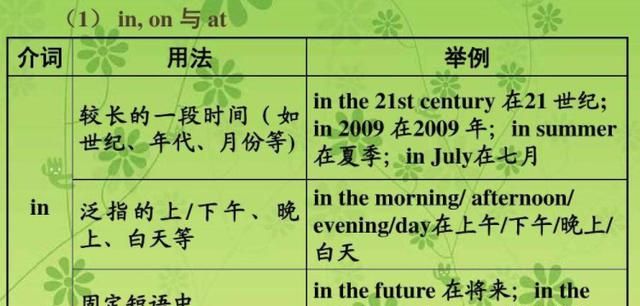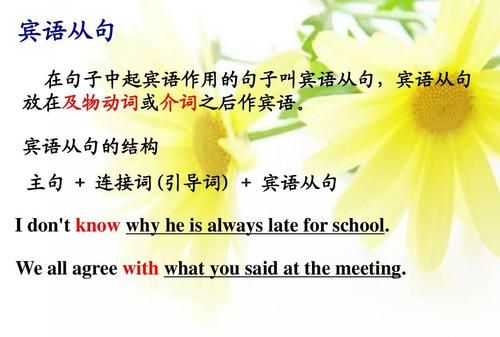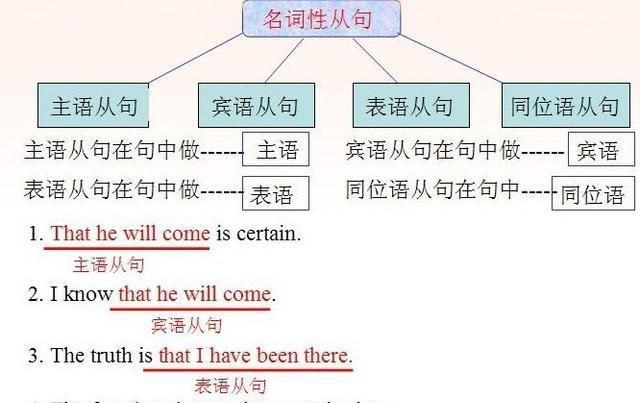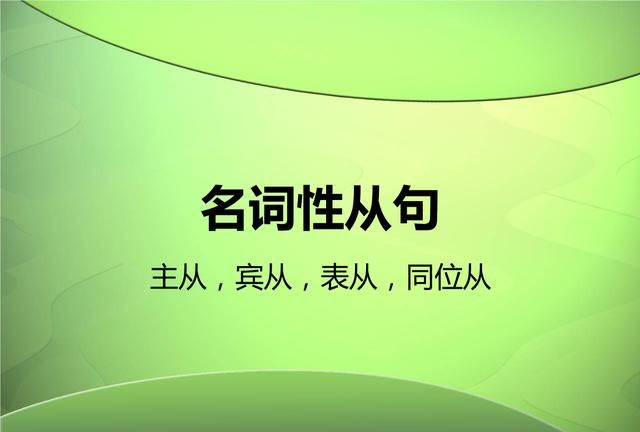本文目录
定语从句介词+which
定语从句及相关术语
1.定语从句:定语从句是由关系代词或关系副词引导的从句,其作用是作定语修饰主句的某个名词性成分,相当于形容词,所以又称为形容词性从句,一般紧跟在它所修饰的先行词后面。
2.关系词:引导定语从句的关联词称为关系词,关系词有关系代词和关系副词。关系代词有that, which, who, whom, whose, as等,绝对没有what;关系副词有where, when, why等。关系词常有3个作用:①引导定语从句。②代替先行词。③在定语从句中担当一个成分。
注:关系代词有主语.宾语之分。一般whom作为宾语。
3.定语:定语用来限定、修饰名词或代词的,是对名词或代词起修饰、限定作用的词、短语或句子,汉语中常用‘……的’表示。主要由形容词担任。此外,名词,代词,数词,分词,副词,不定式以及介词短语也可以来担任,也可以由一个句子来担任.单词作定语时通常放在它所修饰的词之前,作前置定语。短语和从句作定语时则放在所修饰的词之后,作定语后置。
4、先行词:被定语从句修饰的名词、代词称为先行词。
关系代词引导的定语从句举例
关系代词所代替的先行词是人或物的名词或代词,并在句中充当主语、宾语、定语等成分。关系代词在定语从句中作主语时,从句谓语动词的人称和数要和先行词保持一致。
1、who, whom, that
这些词代替的先行词是人的名词或代词,在从句中所起作用如下:
(1) Is he the man who/that wants to see you? 他就是想见你的人吗?(who/that在从句中作主语)
(2) He is the man whom/ that I saw yesterday. 他就是我昨天见的那个人。(whom/that在从句中作宾语)
2、Whose 用来指人或物,(只用作定语, 若指物,它还可以同of which互换,指人的时候也可以用of whom 代替)
(1) They rushed over to help the man whose car had broken down. 那人车坏了,大家都跑过去帮忙。
(2) Please pass me the book whose (of which) cover is green. 请递给我那本绿皮的书。
3、 which, that 它们所代替的先行词是事物的名词或代词,在从句中可作主语、宾语等,例如:
(1) A prosperity which / that had never been seen before appears in the countryside. 农村出现了前所未有的繁荣。(which / that在句中作主语)
(2) The package (which / that) you are carrying is about to come unwrapped. 你拿的包快散了。(which / that在句中作宾语)
[编辑本段]分类
限定性定语从句
一、关系代词(在句中作主语、宾语或定语)
1. that既可代表事物也可代表人,which代表事物;它们在从句中作主语或宾语,that在从句中作宾语时常可省略关系词,which在从句中作宾语也可以省略。[eg:this is the book (which)you want。]
2而且,如果which在从句中作“不及物动词+介词”的介词的宾语,注意介词不要丢掉,而且介词总是放在关系代词which的前边,但有的则放在它原来的位置
3. 代表物时多用which,但在带有下列词的句子中用that而不用which,这些词包括当先行词是anything, everything, nothing , none等不定代词时,或者是由every, any, all, some, no, little, few, much等修饰时等,这时的that常被省略 还有先行词前有序数词或形容词最高级修饰时,或先行词就是序数词或最高级时.以及先行词中既有人又有物时.还有句中前面有which时,都只能用that
4. who和whom引导的从句用来修饰人,分别作从句中的主语和宾语,whom作宾语时,要注意它可以作动词的宾语也可以作介词的宾语
5. whose是关系代词,修饰名词作定语,相当于所修饰成分的前置所有格.它引导的从句可以修饰人和物, 当它引导的从句修饰物体时, 可以与 of which 调换,表达的意思一样。
二、关系副词(在句中作状语)
关系副词=介词+关系代词
why=for which
where=in/ at/ on/ ... which (介词同先行词搭配)
when=during/ on/ in/ ... which (介词同先行词搭配)
1. where是关系副词,用来表示地点的定语从句。
2. when引导定语从句表示时间〔注〕值得一提的是,表示时间“time"一词的定语从句只用when引导,有时不用任何关系代词,当然也不用that引导。
By the time you arrived in London, we had stayed there for two weeks.
I still remember the first time I met her.
Each time he goes to business trip, he brings a lot of living necessities, such as towels, soap, toothbrush etc。
3. 当从句的逻辑主语是some, any, no, somebody, anybody, nobody, something, anything, everything或nothing时,常用there is来引导
There is somebody here who wants to speak to you. 这里有人要和你说话。
非限定性定语从句
非限定性定语从句的作用是对所修饰的成分作进一步说明,通常是引导词和先行词之间用逗号隔开,将从句拿掉后其他部分仍可成立
1. which引导的非限定性定语从句来说明前面整个句子的情况或主句的某一部分
2.当先行词是专有名词或物主代词和指示代词所修饰时,其后的定语从句通常是非限制性的,例如:
Charles Smith, who was my former teacher, retired last year. 查理·史密斯去年退休了,他曾经是我的老师。
My house, which I bought last year, has got a lovely garden. 我去年买的的那幢房子带着个漂亮的花园。
This novel, which I have read three times, is very touching. 这本小说很动人,我已经读了三遍。
3.非限制性定语从句还能将整个主句作为先行词, 对其进行修饰, 这时从句谓语动词要用第三人称单数,例如:
He seems not to have grasped what I meant, which greatly upsets me. 他似乎没抓住我的意思,这使我心烦。
Liquid water changes to vapor, which is called evaporation. 液态水变为蒸汽,这就叫做蒸发。
4. 有时as也可用作关系代词
5. 在非限定性定语从句中,不能用关系副词why和关系代词that,而用who, whom代表人,用which,whose代表事物,如果需要用why,
可用for which代替.;
关系代词引导的定语从句
1.who指人在从句中做主语
(1) The boys who are playing football are from Class One. 在踢足球的男孩们是一班的.
(2) Yesterday I helped an old man who lost his way. 昨天,我帮助了一个迷路的老人.
2. whom指人,在定语从句中充当宾语,常省略。(注:who和whom已无太大区别,基本可以通用。唯一区别是who可以做主语而whom不可以。)
(1) Mr. Liu is the person (whom) you talked with on the bus. 刘先生就是在公交车上和你聊天的那个人.
(2) Mr. Ling is just the boy(whom)I want to see. 凌先生恰巧就是我想见的那个男孩.
(3) The man who/whom you met just now is my friend. 你刚刚见到的那个人就是我的朋友.
注意:关系代词whom在口语和非正式语体中常用who代替,可省略。
如果在从句中做宾语,就用whom或who.比如: He is the man whom/who I talk to. 他就是那个和我聊天的男人.
如果是在从句中作主语就只能用who.比如: He is the man who has an English book. 他就是那个有英语书的男人.
3. whose通常指人,也可指物,在定语从句中做定语。
(1) He has a friend whose father is a doctor.
(2) I once lived in a house whose roof has fallen in.whose指物时,常用以下结构来代替
(3) The classroom whose door is broken will soon be repaired.
(4) The classroom the door of which is broken will soon be repaired.
(5) Do you like the book whose color is yellow?
(6) Do you like the book the color of which is yellow?
4.which指物,在定语从句中做主语或者宾语,做宾语时可省略。
(1) Football is a game which is liked by most boys. 足球是大多数男孩都喜欢的游戏.
(2) This is the pen (which) he bought yesterday. 这是他昨天刚买的钢笔.
5. that指人时,相当于who或者whom;指物时,相当于which。
在定语从句中做主语或者宾语,做宾语时可省略。
(5) The number of the people that/who come to visit the city each year rises one million.
(6) Where is the man that/whom I saw this morning?
关系副词引导的定语从句
1. when指时间,在定语从句中做时间状语
(1) I still remember the day when I first came to the school.
(2) The time when we got together finally came.
2. where指地点,在定语从句中做地点状语
(1) Shanghai is the city where I was born.
(2) The house where I lived ten years ago has been pulled down.
3. why指原因,在定语从句中做原因状语
(1) Please tell me the reason why you missed the plane.
(2) I don’t know the reason why he looks unhappy today.
注意:关系副词引导的从句可以由“介词+关系代词”引导的从句替换
(1) The reason why/ for which he refused the invitation is not clear,
(2) From the year when/in which he was going to school he began to know what he wanted when he grew up.
[编辑本段]介词和关系代词
1)介词后面的关系词不能省略。
2)that前不能有介词。
3) 某些在从句中充当时间,地点或原因状语的"介词+关系词"结构可以同关系副词when ,where和why 互换。 This is the house in which I lived two years ago.
This is the house where I lived two years ago.
Do you remember the day on which you joined our club?
Do you remember the day when you joined our club?
This is the reason why he came late.
This is the reason for which he came late.
介词+关系代词引导的定语从句关系代词在定语从句中做介词宾语时
从句常由介词+关系代词引导
(1) The school (that/which) he once studied in is very famous.
= The school in which he once studied is very famous.
(2) Tomorrow I will bring here a magazine (that/which) you asked for.
= Tomorrow I will bring here a magazine for which you asked.
(3) We’ll go to hear the famous singer (whom/that/who) we have often talked about.
= We’ll go to hear the famous singer about whom we have often talked.
注意:
1. 含有介词的动词短语一般不拆开使用,如:look for, look after, take care of等
T This is the watch which/that I am looking for. (T=正确)
F This is the watch for which I am looking. (F=错误)
2. 若介词放在关系代词前,关系代词指人时用whom,不可用who或者that;指物时用which,不能用that;关系代词是所有格时用whose
(1) The man with whom you talked is my friend. (T)
The man with that you talked is my friend. (F)
(2) The plane in which we flew to Canada is very comfortable. (T)
The plane in that we flew in to Canada is very comfortable. (F)
3. “介词+关系代词”前可有some, any, none, both, all, neither, most, each, few等代词或者数词
(1) He loved his parents deeply, both of whom are very kind to him.
(2) In the basket there are quite many apples, some of which have gone bad.
(3) There are forty students in our class in all, most of whom are from big cities.
关系代词
关系代词(一般情况下)that 可用who ,whom 和which在从句做主语,谓动词的宾语,但是不能做介词的宾语。
which指物,在从句中作主语,谓语或宾语;
who在从句中作主语;
whom在从句中宾语;
where在从句中修饰表地点的名词,做地点状语;
when在从句中通常修饰表时间的名词,做时间状语;
why在从句中做原因状语,先行词通常是"reason"
有时why也可用for+which代替。
例:A doctor is a person who looks after people's health.
______ _ _____ _____________________
主语 谓语 先行词 从句
|________________________|
定语从句修饰先行词
判断介词和关系代词
方法一: 用关系代词,还是关系副词完全取决于从句中的谓语动词。不及物动词后面无宾语,就必须要求用关系副词或者是介词加关系代词;而及物动词后接宾语,则要求用关系代词。例如:
This is the mountain village where I stayed last year.
I'll never forget the days when I worked together with you.
判断改错(注:先显示题,再显示答案,横线;用不同的颜色表示出。)
(错) This is the mountain village where I visited last year.
(错) I will never forget the days when I spent in the countryside.
(对) This is the mountain village (which) I visited last year.
(对) I'll never forget the days (which) I spent in the countryside.
习惯上总把表地点或时间的名词与关系副词 where, when联系在一起。此两题错在关系词的误用上。
方法二: 准确判断先行词在定语从句中的成分(主、谓、宾、定、状),也能正确选择出关系代词/关系副词。例1. Is this museum ___ you visited a few days ago?
A. where B. that C. on which D. the one
例2. Is this the museum ____ the exhibition was held?
A. where B. that C. on which D. the one答案:
例1 D,例2 A
例1变为肯定句: This museum is ___ you visited a few days ago.例2变为肯定句: This is the museum ___ the exhibition was held.
在句1中,is后应跟表语,只有the one可以,而后面的you visited a few days ago则做one的定语从句。
而句2中, 主、谓、宾俱全,从句部分为句子的状语表地点,既可用副词where,又因 in the museum词组,可用介词in + which 引导地点状语。而此题中,介词on 用的不对,所以选A。
关系词的选择依据在从句中所做的成分,先行词在从句中做主、定、宾语时,选择关系代词 (who, whom, that, which, whose);
先行词在从句中做状语时,应选择关系副词 ( where 地点状语,when 时间状语,why 原因状语) 。
[编辑本段]先行词和关系词
1)Whoever spits in public will be punished here. (Whoever 可以用 anyone who 代替)
2)The parents will use what they have to send their son to technical school. (what 可以用all that代替)
但这两句句子已经不是定语从句了,是名词性从句。因为定语从句一定要有先行词,而名词性从句没有。将“Whoever”、“what”分别用“Anyone who”、“all that”代替后,才是定语从句,先行词分别是“Anyone”、“all”。
as,which引导的非限制性定语从句 由as, which 引导的非限定性定语从句,as和which可代整个主句,相当于and this或and that。As一般放在句首,which在句中。
As we know, smoking is harmful to one's health.
The sun heats the earth, which is very important to us.
典型例题
1)Alice received an invitation from her boss, ___came as a surprise.
A. it B. that C. which D. he
答案C。
此为非限定性从句,不能用 that修饰,而用which.,it 和he 都使后句成为句子,两个独立的句子不能单以逗号连接。况且选he句意不通。
2)The weather turned out to be very good, ___ was more than we could expect.
A. what B. which C. that D. it
答案B。
which可代替句子,用于非限定性定语从句,而what不可。That 不能用于非限定性定语从句,it不为连词,使由逗号连接的两个句子并在一起在英语语法上行不通。
3)It rained hard yesterday, ____ prevented me from going to the park..
A. that B. which C. as D. it
答案B。
as 和which在引导非限制性定语从句时,这两个关系代词都指主句所表达的整个意思,且在定语从句中都可以作主语和宾语。但不同之处主要有两点:
(1) as 引导的定语从句可置于句首,而which不可。
(2) as 代表前面的整个主句并在从句中作主语时,从句中的谓语必须是系动词;若为行为动词,则从句中的关系代词只能用which.。
在本题中,prevent由于是行为动词,所以正确选项应为B。
As 的用法例
1. the same… as;such…as 中的as 是一种固定结构, 和……一样……。
I have got into the same trouble as he (has).
例2. as可引导非限制性从句,常带有'正如'。
As we know, smoking is harmful to one's health.
As is known, smoking is harmful to one's health.
As是关系代词。例1中的as作know的宾语;
例2中,它充当从句的主语,谓语动词know要用被动式。
一、“as / which” 特殊定语从句的先行成分
1. 形容词或形容词短语作先行成分, 具有形容词意义的介词短语也可以充当先行成分,如:
My grandmother’s house was always of great importance to me, as my own is.
在一定的语言环境里,有些名词可以具有形容词的性质。这些名词主要是那些表示人的身份、职业、状态的名词。值得一提的是,在这些具有形容词性质的名词之后,引导定语从句的关系代词不能用who / whom.
2. 动词短语先行成分。
这种动词短语既可是限定形式也可是非限定形式。如果是动态动词短语,它们在从句中就一般有限定或非限定形式的替代动词do和as / which一起代替。do可以出现,也可以不出现,但不能用其它动词代替。
3. 句子作先行成分。
这句子可以是整个主句也可以只是主句中的一个从句。有时是连续几个句子,有时甚至可以是一个完整的故事。
二、“as/which”特殊定语从句在句中的位置
由于先行成分的构成成分不同,“as/which”特殊定语从句在句中的位置有以下几种情况:
1. 形容词做先行成分时:形容词或形容词短语(含具有形容词性质的名词)作先行成分,“as / which”特殊定语从句置于先行成分之后。
2. 动词短语作先行成分时:动词短语作先行成分时,“as / which”特殊定语从句置于先行成分之后。但是,当从句中含有表示主观意志的插入成分时,“as”特殊定语从句可以移至句子之首。
3. 句子作先行成分时:“as”特殊定语从句的位置较灵活,可以置于先行成分之前、之中或之后。但如果先行成分是直接引语,“as”特殊定语从句多在先行成分之前。如果先行成分是否定句,“as”特殊定语从句与否定词的相对位置不同可以使它产生不同的意义。由于“as”特殊定语从句具有这一特点,所以有时它的位置不能随便移动。在非正式的文体里,“which”特殊定语从句可以出现在先行成分之中

介词后面可以加that引导的宾语从句吗
由which引导的定语从句,介词提前.
in
which可以翻译成在......里面;
of
which可以翻译成……的;on
which可以翻译成在......的上面,或具体时间的某一天
.
所以介词+which/whom
+
从句。是定语从句
而不是名词性从句。例:
is
this
the
house
in
which
shakespeare
was
born
?
这个就是莎士比亚住过的房子吗?
in
the
dark
street
,
there
wasn’t
a
single
person
to
whom
she
could
turn
for
help
在黑暗的街道上,没有一个人可以给她以帮助。
i
will
never
forget
the
day
on
which
i
first
came
to
new
york.

名词性从句详解PPT课件
名词性从句是由if, whether, that 和各种疑问词充当连接词所引导的从句,其功同名词一样。
一.主语从句
主语从句是在复合句中充当主语的从句,通常放在主句谓语动词之前或由形式主语it代替,而本身放在句子末尾。
1. It 作形式主语和it引导强调句的比较
It 作形式主语代替主语从句,主要是为了平衡句子结构,主语从句的连接词没有变化。而it引导的强调句则是对句子某一部分进行强调,无论强调的是什么成分,都可用连词that。被强调部分指人是也可用who/whom。例如:
It is a pity that you didn’t go to see the film.
It doesn’t interest me whether you succeed or not.
It is in the morning that the murder took place.
It is John that broke the window.
2. 用it 作形式主语的结构
(1) It is +名词+从句
It is a fact that … 事实是…
It is an honor that …非常荣幸
It is common knowledge that …是常识
(2) it is +形容词+从句
It is natural that… 很自然…
It is strange that… 奇怪的是…
(3) it is +不及物动词+从句
It seems that… 似乎…
It happened that… 碰巧…
(4) it +过去分词+从句
It is reported that… 据报道…
It has been proved that… 已证实…
3. 主语从句不可位于句首的五种情况
(1) if 引导的主语从句不可居于复合句句首。
(2) It is said , (reported) …结构中的主语从句不可提前。例如:
It is said that President Jingo will visit our school next week. (right)
That President Jiang will visit our school next week is said. (wrong)
(3) It happens…, It occurs… 结构中的主语从句不可提前。例如:
It occurred to him that he failed in the examination. (right)
That he failed in the examination occurred to him. (wrong)
(4) It doesn’t matter how/whether …结构中的主语从句不可提前。例如:
It doesn’t matter whether he is wrong or not. (right)
Whether he is wrong or not doesn’t matter. (wrong)
(5) 含主语从句的复合句是疑问句时,主语从句不可提前。例如:
Is it likely that it will rain in the evening? (right)
Is that will rain in the evening likely? (wrong)
4. What 与that 在引导主语从句时的区别
What 引导主语从句时在句时在从句中充当句子成分,如主语.宾语.表语,而that 则不然。例如:
1) What you said yesterday is right.
2) That she is still alive is a consolation.
二.宾语从句
宾语从句就是在复合句中作宾语的名词性从句,通常放在主句谓语动词(及物动词)或介词之后。
1. 作动词的宾语
(1) 由that引导的宾语从句(that 通常可以省略),例如:
I heard that be joined the army.
(2) 由what, whether (if) 引导的宾语从句,例如:
1) She did not know what had happened.
2) I wonder whether you can change this note for me.
(3) 动词+间接宾语+宾语从句。例如:
She told me that she would accept my invitation.
2. 作介词的宾语
例如:Our success depends upon how well we can cooperate with one another.
3. 作形容词的宾语
例如:I am afraid (that) I’ve made a mistake.
That 引导的从句常跟在下列形容词后作宾语:
Anxious, aware, certain, confident, convinced, determined, glad, proud, surprised, worried, sorry, thankful, ashamed, disappointed, annoyed, pleased, hurt, satisfied, content 等。也可以将此类词后的that 从句的看作原因状语从句。
4. It 可以作为形式宾语
It 不仅可以作为形式主语,还可以作为形式宾语而真正的宾语that 从句则放在句尾,特别是在带复合宾语的句子中。 例如:
We heard it that she would get married next month..
5. 后边不能直接跟that 从句的动词
这类动词有Allow, refuse, let, like, cause, force, admire, condemn, celebrate, dislike, love, help, take, forgive等。这类词后可以用不定式或动名词作宾语,但不可以用that引导的宾语从句。例如:
I admire their winning the match. (right)
I admire that they won the match. (wrong)
6. 不可用that从句作直接宾语的动词
有些动词不可用于“动词+间接宾语+that从句“结构中,常见的有Envy, order, accuse, refuse, impress, forgive, blame, denounce, advise, congratulate等。例如:
He impressed the manager as an honest man. (right)
He impressed the manager that he was an honest man. (wrong)
7. 否定的转移
若主句谓语动词为Think, consider, wuppose, believe, expect, fancy, guess, imagine等,其后的宾语从句若含有否定意义,一般要把否定词转移到主句谓语上,从句谓语用肯定式。例如:
I don’t think this dress fits you well.(我认为这件衣服不适合你穿。)
三.表语从句
表语从句在复合句中作表语的名词性从句,放在系动词之后,一般结构是“主语+连系动词+表语从句”。可以接表语从句的连系动词有be, look, remain, seem等。引导表语从句的that常可省略。另外,常用的还有the reason is that… 和It is because 等结构。例如:
1) The question is whether we can make good preparation in such a short time.
2) This is why we can’t get the support of the people
3) But the fact remains that we are behind the other classes.
4) The reason he is late for school is that he missed the early bus.
四.同位语从句
同位语从句就是在复合句中作名词的同位语的名词性从句。
1. 同位语从句的功能
同位语从句对于名词进一步解释,说明名词的具体内容,一般由that引导,例如:
1) The king’s decision that the prisoner would be set free surprised all the people.
2) The order that all the soldiers should stay still is given by the general.
2. 同位语在句子中的位置
同位语从句有时可以不紧跟在它所说明的名词后面,而是被别的词隔开。例如:
He got the news from Mary that the sports meeting was put off.
3. 同位语从句与定语从句的区别
(1) 定语从句中的that既代替先行词,同时以在从句中作某个成分(主语或宾语),而同位语从句中的that是连词,只起连接主句与从句的作用,不充当句中任何成分。
(2) 定语从句是形容词性的,其功能是修饰先行词,对先行词加以限定,描述定的性质或特征;同位语从句是名词性的,其功能是对名词进行补充说明。例如:
1) The news that he told me is that Tom would go abroad next year.(他告诉我的消息是汤姆明年将出国。)(第一个that引导的从句是定语从句,that在从句中作宾语)
2)The news that Tom would go abroad is told by him.(汤姆将出国的消息是他讲的。)(同位语从句,that在句中不作任何成分)
***/English/0001/1382.htm
这里也有
***.cn/Article/FREE_YY/YFBD/200485144806.asp
***/Article/jiaoxi/200605/1291.html

名词性从句介词后用什么引导词
由which引导的定语从句,介词提前. in which可以翻译成在......里面; of which可以翻译成……的;on which可以翻译成在......的上面,或具体时间的某一天 . 所以介词+which/whom + 从句。是定语从句 而不是名词性从句。例:
Is this the house in which Shakespeare was born ? 这个就是莎士比亚住过的房子吗?
In the dark street , there wasn’t a single person to whom she could turn for help
在黑暗的街道上,没有一个人可以给她以帮助。
I will never forget the day on which I first came to New York.

以上就是关于名词性从句介词提前 ,定语从句介词+which的全部内容,以及名词性从句介词提前 的相关内容,希望能够帮到您。

